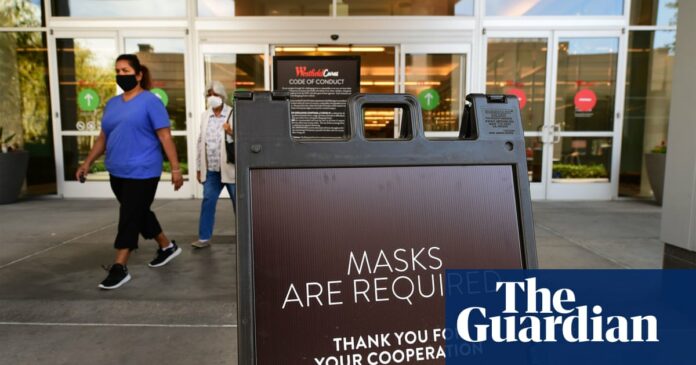The number of coronavirus deaths in California surpassed 5,000 over the weekend, even as malls, museums and movie theaters began to reopen across the state.
The rise in cases has left epidemiologists and healthcare providers uneasy about whether the Golden State – which until now has been considered a national leader in aggressively containing the pandemic – will start to regress.
California has now recorded about 153,500 Covid-19 cases, with cases increasing by more than 2,000 over the weekend. Much of that can be attributed to increased testing, health officials say. But the grim statistics also reflect an explosion of cases in Imperial county, which borders Mexico, as well as a spike in Los Angeles.
“The continued growth of the epidemic in southern California is of huge concern,” said George Rutherford, an epidemiologist at the University of California San Francisco. “We can’t turn the corner of this epidemic until we turn a corner there.”
In Los Angeles, coronavirus hospitalizations have slowed, but per a tracker developed by the Mercury News, Los Angeles county saw nearly 1,000 new cases by Sunday night, and 17 deaths – more than half of the daily total of reported deaths in the state.
As cases and deaths continued to rise in Imperial county, more than 1,600 residents signed a letter asking the California governor Gavin Newsom and state officials to intervene, even as local supervisors pushed to reopen more businesses despite the health crisis. The state requires counties to show that 8% or fewer Covid-19 tests have come back positive for at least a week straight in order to ease pandemic restrictions. In Imperial county, 24% of tests are coming back positive.
“The area is medically underserved, but it’s also economically depressed,” said Luis Flores Jr, who drafted an open letter to California officials. With the regional medical center overwhelmed, coronavirus patients were flown to hospitals hundreds of miles away. At the same time, the rural county – where nearly 85% of residents identify as Hispanic or Latino, and many work in the service industry, meat packing and agriculture – has largely been left out of some of the government relief packages.
“My parents in that way are lucky that they have kids who speak English, who can help them navigate the process to get small business loans for their shop,” Flores said. “A lot of folks don’t have that access to relief.”
But the answer isn’t necessarily to rush to reopen businesses, Flores said. “The county is making this into a way between the economy and health,” he told the Guardian. “When really there’s a third option: we could slow down and appeal for more resources and support.”
Across the state, the pandemic is continuing to take a disproportionate toll on Black and Latino residents. Advocates are also concerned about the spread of disease in prisons and homeless shelters.
“I wouldn’t say it’s all safe now, I’d say it’s less unsafe,” said Rutherford. There are signs of progress, he said. California has now conducted more than 2.86m diagnostic tests – including about 78,000 completed just on Sunday. The state is also on track to train more than 10,000 contact tracers by July, officials say.
Overall, the positive test rate in the state has continued to decline, averaging at 4.5% over the past fortnight. And the number of hospitalizations and ICU admissions have remained stable. The records don’t currently reflect a spike following weeks of protests against police brutality, though officials said there could be an uptick in coming weeks. Symptoms can take up to 14 days to appear, and those who may have contracted the virus at protests may not notice right away. Officials in many counties are encouraging those who’ve attended demonstrations to get tested.
“As long as we have testing and contact tracing there are a lot of things we can do this summer that would have been unthinkable three months ago,” Rutherford said. As of 12 June, the state allowed 51 out of 58 counties to reopen restaurants, hair salons, zoos, gyms, wineries and other businesses. Retailers and places of worship have also been allowed to reopen throughout the state.
Establishments are required to follow certain guidelines, like maintaining social distancing, especially in indoor spaces, and requiring patrons to wear masks. Rutherford said he’s concerned that these guidelines are often flouted. In Orange county, the health director rescinded a mask mandate after pushback from residents and local officials, revising guidelines to recommend, but not require, that people wear face coverings in public. In LA, health officials who visited about 2,000 restaurants over the weekend found that half weren’t complying with safety guidelines.
Still, Rutherford said he was heartened that early and aggressive shelter-in-place policies kept transmission low. Community-wide studies in the San Francisco Bay area have found that only 1% to 1.5% of some regions have been infected. “We took a whole chunk out of the epidemic early on,” Rutherford said. “But now we can be more surgical and effective in tracking and tracing cases even as businesses open up.”






